- Home
- Jared Diamond
Collapse: How Societies Choose to Fail or Succeed Page 14
Collapse: How Societies Choose to Fail or Succeed Read online
Page 14
The whole operation of constructing statues and platforms must have been enormously expensive of food resources for whose accumulation, transport, and delivery the chiefs commissioning the statues must have arranged. Twenty carvers had to be fed for a month, they may also have been paid in food, then a transport crew of 50 to 500 people and a similar erecting crew had to be fed while doing hard physical work and thus requiring more food than usual. There must also have been much feasting for the whole clan owning the ahu, and for the clans across whose territories the statue was transported. Archaeologists who first tried to calculate the work performed, the calories burned, and hence the food consumed overlooked the fact that the statue itself was the smaller part of the operation: an ahu outweighed its statues by a factor of about 20 times, and all that stone for the ahu also had to be transported. Jo Anne Van Tilburg and her architect husband Jan, whose business it is to erect large modern buildings in Los Angeles and to calculate the work involved for cranes and elevators, did a rough calculation of the corresponding work on Easter. They concluded that, given the number and size of Easter’s ahu and moai, the work of constructing them added about 25% to the food requirements of Easter’s population over the 300 peak years of construction. Those calculations explain Chris Stevenson’s recognition that those 300 peak years coincided with the centuries of plantation agriculture in Easter’s interior uplands, producing a large food surplus over that available previously.
However, we have glossed over another problem. The statue operation required not only lots of food, but also lots of thick long ropes (made in Polynesia from fibrous tree bark) by which 50 to 500 people could drag statues weighing 10 to 90 tons, and also lots of big strong trees to obtain all the timber needed for the sleds, canoe ladders, and levers. But the Easter Island seen by Roggeveen and subsequent European visitors had very few trees, all of them small and less than 10 feet tall: the most nearly treeless island in all of Polynesia. Where were the trees that provided the required rope and timber?
Botanical surveys of plants living on Easter within the 20th century have identified only 48 native species, even the biggest of them (the toromiro, up to seven feet tall) hardly worthy of being called a tree, and the rest of them low ferns, grasses, sedges, and shrubs. However, several methods for recovering remains of vanished plants have shown within the last few decades that, for hundreds of thousands of years before human arrival and still during the early days of human settlement, Easter was not at all a barren wasteland but a subtropical forest of tall trees and woody bushes.
The first such method to yield results was the technique of pollen analysis (palynology), which involves boring out a column of sediment deposited in a swamp or pond. In such a column, provided that it has not been shaken or disturbed, the surface mud must have been deposited most recently, while more deeply buried mud represents more ancient deposits. The actual age of each layer in the deposit can be dated by radiocarbon methods. There remains the incredibly tedious task of examining tens of thousands of pollen grains in the column under a microscope, counting them, and then identifying the plant species producing each grain by comparison with modern pollen from known plant species. For Easter Island the first bleary-eyed scientist to perform that task was the Swedish palynologist Olof Selling, who examined cores collected from the swamps in Rano Raraku’s and Rano Kau’s craters by Heyerdahl’s 1955 expedition. He detected abundant pollen of an unidentified species of palm tree, of which Easter today has no native species.
In 1977 and 1983 John Flenley collected many more sediment cores and again noticed abundant palm pollen, but by good luck Flenley in 1983 also obtained from Sergio Rapu Haoa some fossil palm nuts that visiting French cave explorers had discovered that year in a lava cave, and he sent them to the world’s leading palm expert for identification. The nuts turned out to be very similar to, but slightly larger than, those of the world’s largest existing palm tree, the Chilean wine palm, which grows up to 65 feet tall and 3 feet in diameter. Subsequent visitors to Easter have found more evidence of the palm, in the form of casts of its trunks buried in Mt. Terevaka’s lava flows a few hundred thousand years ago, and casts of its root bundles proving that the Easter palm’s trunk reached diameters exceeding seven feet. It thus dwarfed even the Chilean palm and was (while it existed) the biggest palm in the world.
Chileans prize their palm today for several reasons, and Easter Islanders would have done so as well. As the name implies, the trunk yields a sweet sap that can be fermented to make wine or boiled down to make honey or sugar. The nuts’ oily kernels are rated a delicacy. The fronds are ideal for fabricating into house thatching, baskets, mats, and boat sails. And of course the stout trunks would have served to transport and erect moai, and perhaps to make rafts.
Flenley and Sarah King recognized pollen of five other now-extinct trees in the sediment cores. More recently, the French archaeologist Catherine Orliac has been sieving out 30,000 fragments of wood burned to charcoal from cores dug into Easter Island ovens and garbage heaps. With a heroism matching that of Selling, Flenley, and King, she has compared 2,300 of those carbonized wood fragments to wood samples of plants still existing today elsewhere in Polynesia. In that way she has identified about 16 other plant species, most of them trees related to or the same as tree species still widespread in East Polynesia, that formerly grew on Easter Island as well. Thus, Easter used to support a diverse forest.
Many of those 21 vanished species besides the palm would have been valuable to the islanders. Two of the tallest trees, Alphitonia cf. zizyphoides and Elaeocarpus cf. rarotongensis (up to 100 and 50 feet tall respectively), are used elsewhere in Polynesia for making canoes and would have been much better suited to that purpose than was the palm. Polynesians everywhere make rope from the bark of the hauhau Triumfetta semitriloba, and that was presumably how Easter Islanders dragged their statues. Bark of the paper mulberry Broussonetia papyrifera is beaten into tapa cloth; Psydrax odorata has a flexible straight trunk suited for making harpoons and outriggers; the Malay apple Syzygium malaccense bears an edible fruit; the oceanic rose-wood Thespesia populanea and at least eight other species have hardwood suitable for carving and construction; toromiro yields an excellent wood for fires, like acacia and mesquite; and the fact that Orliac recovered all of those species as burnt fragments from fires proves that they too were used for firewood.
The person who pored through 6,433 bones of birds and other vertebrates from early middens at Anakena Beach, probably the site of the first human landing and first settlement on Easter, was zooarchaeologist David Steadman. As an ornithologist myself, I bow in awe before Dave’s identification skills and tolerance of eye strain: whereas I wouldn’t know how to tell a robin’s bone from a dove’s or even from a rat’s, Dave has learned how to distinguish even the bones of a dozen closely related petrel species from each other. He thereby proved that Easter, which today supports not a single species of native land bird, was formerly home to at least six of them, including one species of heron, two chicken-like rails, two parrots, and a barn owl. More impressive was Easter’s prodigious total of at least 25 nesting seabird species, making it formerly the richest breeding site in all of Polynesia and probably in the whole Pacific. They included albatross, boobies, frigatebirds, fulmars, petrels, prions, shearwaters, storm-petrels, terns, and tropicbirds, attracted by Easter’s remote location and complete lack of predators that made it an ideal safe haven as a breeding site—until humans arrived. Dave also recovered a few bones of seals, which breed today on the Galápagos Islands and the Juan Fernández Islands to the east of Easter, but it is uncertain whether those few seal bones on Easter similarly came from former breeding colonies or just vagrant individuals.
The Anakena excavations that yielded those bird and seal bones tell us much about the diet and lifestyle of Easter’s first human settlers. Out of those 6,433 vertebrate bones identified in their middens, the most frequent ones, accounting for more than one-third of the total, proved to belong to the la
rgest animal available to Easter Islanders: the Common Dolphin, a porpoise weighing up to 165 pounds. That’s astonishing: nowhere else in Polynesia do porpoises account for even as much as 1% of the bones in middens. The Common Dolphin generally lives out to sea, hence it could not have been hunted by line-fishing or spear-fishing from shore. Instead, it must have been harpooned far offshore, in big seaworthy canoes built from the tall trees identified by Catherine Orliac.
Fish bones also occur in the middens but account there for only 23% of all bones, whereas elsewhere in Polynesia they were the main food (90% or more of all the bones). That low contribution of fish to Easter diets was because of its rugged coastline and steep drop-offs of the ocean bottom, so that there are few places to catch fish by net or handline in shallow water. For the same reason the Easter diet was low in molluscs and sea urchins. To compensate, there were those abundant seabirds plus the land birds. Bird stew would have been seasoned with meat from large numbers of rats, which reached Easter as stowaways in the canoes of the Polynesian colonists. Easter is the sole known Polynesian island at whose archaeological sites rat bones outnumber fish bones. In case you’re squeamish and consider rats inedible, I still recall, from my years of living in England in the late 1950s, recipes for creamed laboratory rat that my British biologist friends who kept them for experiments also used to supplement their diet during their years of wartime food rationing.
Porpoises, fish, shellfish, birds, and rats did not exhaust the list of meat sources available to Easter’s first settlers. I already mentioned a few seal records, and other bones testify to the occasional availability of sea turtles and perhaps of large lizards. All those delicacies were cooked over firewood that can be identified as having come from Easter’s subsequently vanished forests.
Comparison of those early garbage deposits with late prehistoric ones or with conditions on modern Easter reveals big changes in those initially bountiful food sources. Porpoises, and open-ocean fish like tuna, virtually disappeared from the islanders’ diet, for reasons to be mentioned below. The fish that continued to be caught were mainly inshore species. Land birds disappeared completely from the diet, for the simple reason that every species became extinct from some combination of overhunting, deforestation, and predation by rats. It was the worst catastrophe to befall Pacific island birds, surpassing even the record on New Zealand and Hawaii, where to be sure the moas and flightless geese and other species became extinct but many other species managed to survive. No Pacific island other than Easter ended up without any native land birds. Of the 25 or more formerly breeding seabirds, overharvesting and rat predation brought the result that 24 no longer breed on Easter itself, about 9 are now confined to breeding in modest numbers on a few rocky islets off Easter’s coasts, and 15 have been eliminated on those islets as well. Even shellfish were overexploited, so that people ended up eating fewer of the esteemed large cowries and more of the second-choice smaller black snails, and the sizes of both cowry and snail shells in the middens decreased with time because of preferential overharvesting of larger individuals.
The giant palm, and all the other now-extinct trees identified by Catherine Orliac, John Flenley, and Sarah King, disappeared for half a dozen reasons that we can document or infer. Orliac’s charcoal samples from ovens prove directly that trees were being burned for firewood. They were also being burned to cremate bodies: Easter crematoria contain remains of thousands of bodies and huge amounts of human bone ash, implying massive fuel consumption for the purposes of cremation. Trees were being cleared for gardens, because most of Easter’s land surface except at the highest elevations ended up being used to grow crops. From the early midden abundance of bones of open-ocean porpoises and tuna, we infer that big trees like Alphitonia and Elaeocarpus were being felled to make seaworthy canoes; the frail, leaky little watercraft seen by Roggeveen would not have served for harpooning platforms or venturing far out to sea. We infer that trees furnished timber and rope for transporting and erecting statues, and undoubtedly for a multitude of other purposes. The rats introduced accidentally as stowaways “used” the palm tree and doubtless other trees for their own purposes: every Easter palm nut that has been recovered shows tooth marks from rats gnawing on it and would have been incapable of germinating.
Deforestation must have begun some time after human arrival by A.D. 900, and must have been completed by 1722, when Roggeveen arrived and saw no trees over 10 feet tall. Can we specify more closely when, between those dates of 900 and 1722, deforestation occurred? There are five types of evidence to guide us. Most radiocarbon dates on the palm nuts themselves are before 1500, suggesting that the palm became rare or extinct thereafter. On the Poike Peninsula, which has Easter’s most infertile soils and hence was probably deforested first, the palms disappeared by around 1400, and charcoal from forest clearance disappeared around 1440 although later signs of agriculture attest to continued human presence there. Orliac’s radiocarbon-dated charcoal samples from ovens and garbage pits show wood charcoal being replaced by herb and grass fuels after 1640, even at elite houses that might have claimed the last precious trees after none was left for the peasants. Flenley’s pollen cores show the disappearance of palm, tree daisy, toromiro, and shrub pollen, and their replacement by grass and herb pollen, between 900 and 1300, but radiocarbon dates on sediment cores are a less direct clock for deforestation than are direct dates on the palms and their nuts. Finally, the upland plantations that Chris Stevenson studied, and whose operation may have paralleled the period of maximum timber and rope use for statues, were maintained from the early 1400s to the 1600s. All this suggests that forest clearance began soon after human arrival, reached its peak around 1400, and was virtually complete by dates that varied locally between the early 1400s and the 1600s.
The overall picture for Easter is the most extreme example of forest destruction in the Pacific, and among the most extreme in the world: the whole forest gone, and all of its tree species extinct. Immediate consequences for the islanders were losses of raw materials, losses of wild-caught foods, and decreased crop yields.
Raw materials lost or else available only in greatly decreased amounts consisted of everything made from native plants and birds, including wood, rope, bark to manufacture bark cloth, and feathers. Lack of large timber and rope brought an end to the transport and erection of statues, and also to the construction of seagoing canoes. When five of Easter’s little two-man leaky canoes paddled out to trade with a French ship anchored off Easter in 1838, its captain reported, “All the natives repeated often and excitedly the word miru and became impatient because they saw that we did not understand it: this word is the name of the timber used by Polynesians to make their canoes. This was what they wanted most, and they used every means to make us understand this ...” The name “Terevaka” for Easter’s largest and highest mountain means “place to get canoes”: before its slopes were stripped of their trees to convert them to plantations, they were used for timber, and they are still littered with the stone drills, scrapers, knives, chisels, and other woodworking and canoe-building tools from that period. Lack of large timber also meant that people were without wood for fuel to keep themselves warm during Easter’s winter nights of wind and driving rain at a temperature of 50 degrees Fahrenheit. Instead, after 1650 Easter’s inhabitants were reduced to burning herbs, grasses, and sugarcane scraps and other crop wastes for fuel. There would have been fierce competition for the remaining woody shrubs, among people trying to obtain thatching and small pieces of wood for houses, wood for implements, and bark cloth. Even funeral practices had to be changed: cremation, which had required burning much wood per body, became impractical and yielded to mummification and bone burials.
Most sources of wild food were lost. Without seagoing canoes, bones of porpoises, which had been the islanders’ principal meat during the first centuries, virtually disappeared from middens by 1500, as did tuna and pelagic fish. Midden numbers of fishhooks and fish bones in general also declined, leaving ma
inly just fish species that could be caught in shallow water or from the shore. Land birds disappeared completely, and seabirds were reduced to relict populations of one-third of Easter’s original species, confined to breeding on a few offshore islets. Palm nuts, Malay apples, and all other wild fruits dropped out of the diet. The shellfish consumed became smaller species and smaller and many fewer individuals. The only wild food source whose availability remained unchanged was rats.
In addition to those drastic decreases in wild food sources, crop yields also decreased, for several reasons. Deforestation led locally to soil erosion by rain and wind, as shown by huge increases in the quantities of soil-derived metal ions carried into Flenley’s swamp sediment cores. For example, excavations on the Poike Peninsula show that crops were initially grown there interspersed with palm trees left standing, so that their crowns could shade and protect the soil and crops against hot sun, evaporation, wind, and direct rain impacts. Clearance of the palms led to massive erosion that buried ahu and buildings downhill with soil, and that forced the abandonment of Poike’s fields around 1400. Once grassland had established itself on Poike, farming was resumed there around 1500, to be abandoned again a century later in a second wave of erosion. Other damages to soil that resulted from deforestation and reduced crop yields included desiccation and nutrient leaching. Farmers found themselves without most of the wild plant leaves, fruit, and twigs that they had been using as compost.

 Why Is Sex Fun?: The Evolution of Human Sexuality
Why Is Sex Fun?: The Evolution of Human Sexuality Guns, Germs, and Steel: The Fates of Human Societies
Guns, Germs, and Steel: The Fates of Human Societies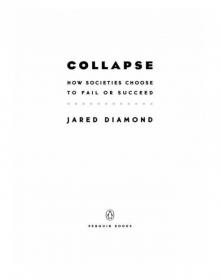 Collapse: How Societies Choose to Fail or Succeed
Collapse: How Societies Choose to Fail or Succeed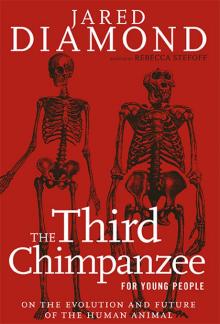 The Third Chimpanzee: The Evolution and Future of the Human Animal
The Third Chimpanzee: The Evolution and Future of the Human Animal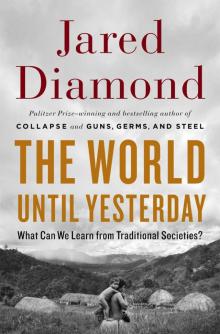 The World Until Yesterday: What Can We Learn From Traditional Societies?
The World Until Yesterday: What Can We Learn From Traditional Societies?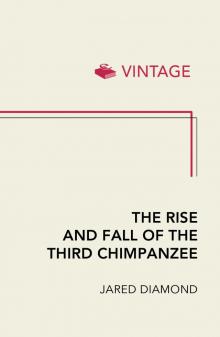 The Rise and Fall of the Third Chimpanzee
The Rise and Fall of the Third Chimpanzee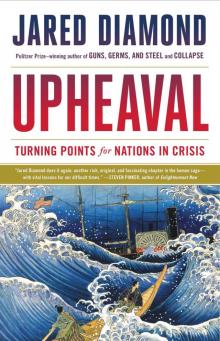 Upheaval: Turning Points for Nations in Crisis
Upheaval: Turning Points for Nations in Crisis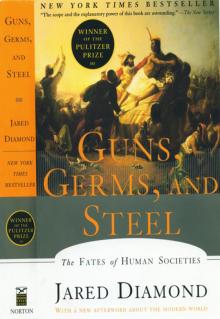 Guns, Germs, and Steel
Guns, Germs, and Steel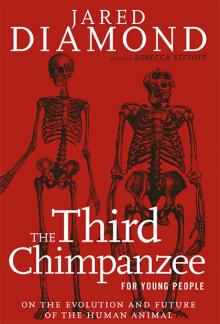 The Third Chimpanzee for Young People
The Third Chimpanzee for Young People Why Is Sex Fun?
Why Is Sex Fun?